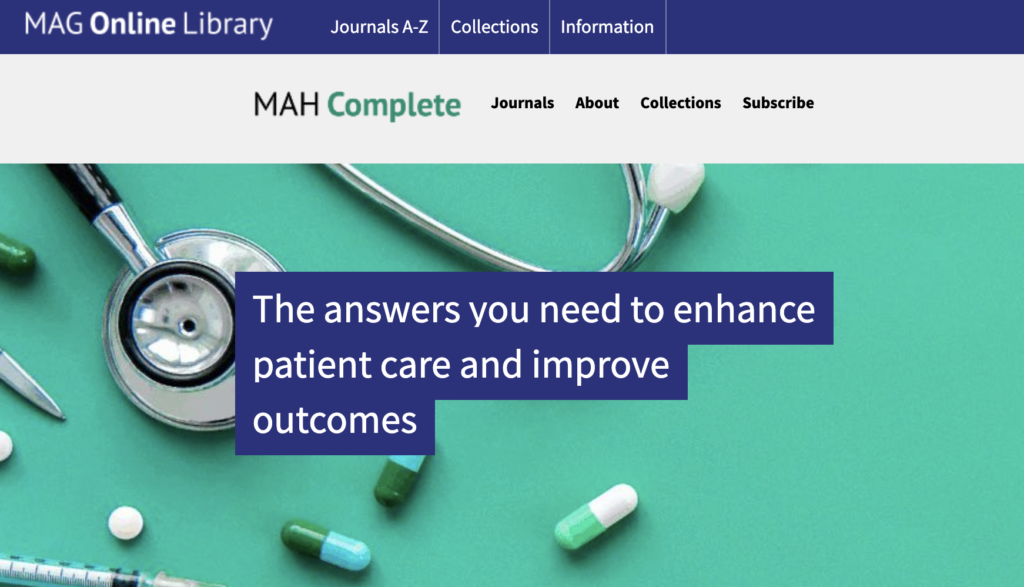How can media businesses repackage their content to reach new global audiences, or even develop completely new mobile subscription products?
Matt Cianfarani, Digital Director for Mark Allen Group shared his experiences developing two digital subscription products at a Round Table discussion recently. And other leaders of independent publishers contributed their thoughts on developing digital products.
Digital product development at Mark Allen Group
Mark Allen Group is a diversified B2B publisher in engineering, healthcare, farming, education, music…
Matt has successfully developed new products based on digital paid content, enterprise subs and recurring revenue.
MAG Online Library
MAG have 30 healthcare and professional journals and realised there was a global market for digital content. Lots of academic and corporate libraries had a budget to buy reference content, even controlled circulation B2B magazines. Users were the students, academics, researchers in pharma, but the buyers were the librarians. Nursing had less information available than professional resources for medics.
Had to hire in enterprise sales professionals, largely from academic publishers, as a different set of skills. Most enterprises have their own systems that they use to search for content.
They chose a platform that took the content from the academic journals, turned it into XML and made it easily accessible. Usability is the big driver in recurring revenue, as if you don’t get usage you won’t get renewals. Make the first sale, encourage usage, obtain that first renewal, and then you should get 95% renewals for life.
Next discipline required was customer success – how to encourage users to access the product and content more frequently, eg promoting new content.
After five years, the library is very profitable with sustainable growth. It is truly global – with agents in Australia, US and India.
Inform digital data products
Community Care Inform is a digital service for social workers, sold to local authorities. Saw the opportunity, as health care and social care work more closely, to expand the idea to healthcare content.
The team ran a market research project, talking to end users about their pain points and information needs. What came back was a need for bite sized information, and ideally on their phone as they go about their work.
They ran product development workshops (supported by agencies) to identify features, using post it notes or digital equivalents.
That gets you to a prototype – one step before a Minimum Viable Product (MVP). This gets your product into people’s hands – it has content, some basic navigation but doesn’t have full functionality. This has been coded on Umbraco, which is an equivalent to WordPress, and was already being used for in-house development. It’s worth picking a platform and sticking to it to quickly develop a product that is more of an MVP than a prototype. We have a group of launch customers who we are working with to develop the product.
The next step is launching to enterprise customers and ensuring there is enough of a database at the back to track how users are accessing the content. Better to have a simple product that works in a limited way, and then issue upgrades later – people are used to software and digital products being upgraded. So for example, can offer personalisation at the start just via simple tagging. Later maybe can use AI and be more sophisticated.
Discussion points
Prototype vs MVP – a good way to manage the tech investment – starting with more basic tools and creating a clickable product. MAG have used a tool called Invision – that creates apps. Can buy an iphone, install the prototype and then show to users who can explore the content. AI can provide more personalisation, and recommendations (which drive usage) but it gets very expensive very quickly.
Mobile web site vs app – started with mobile web, makes it easier for people to access via eg Google scholar, and development cheaper. May create a true app later, as some users may be out and about and need offline access.
Launch partners – for the more established product, have an advisory board of librarians. For the new product, have some beta customers who provide feedback, help development.
Resources
Whiteboard application – Mural (https://www.mural.co/) good for collaborative post-it sessions
Digital product design platform – Invision (https://www.invisionapp.com/)
Boomtrain did a personalisation plugin for Word Press but they got acquired by https://zetaglobal.com/
Speciall Media Group
This Round Table was organised for members of the Speciall Media Group, an invite-only online community for leaders of independent B2B and B2C media and publishing businesses. We have over 100 members, and as well as an online forum hosted by Guild, we run occasional surveys and online round tables where members share their experiences. Find out more and request to join here.
https://guild.co/groups/742/speciall-media-group
About the author
Carolyn Morgan has bought, sold, launched and grown specialist media businesses across print, digital and live events. A founder of the Specialist Media Show (sold in 2014) she now advises media businesses large and small on their digital strategy through her consultancy Speciall Media.

